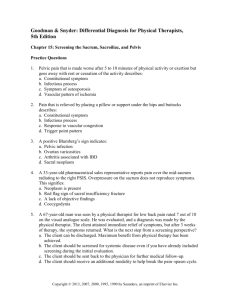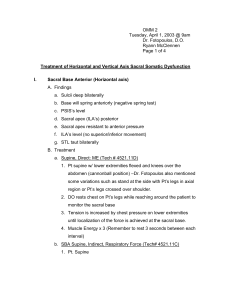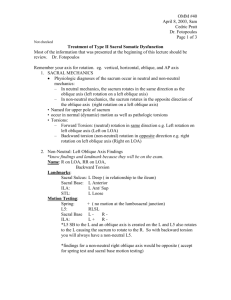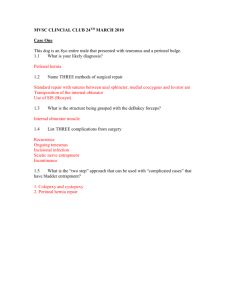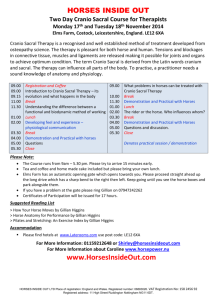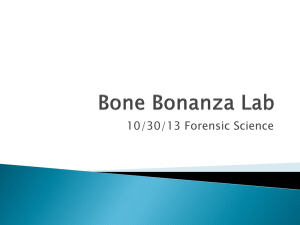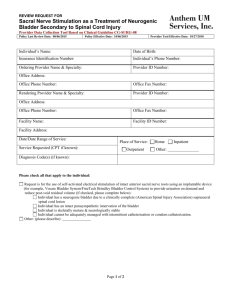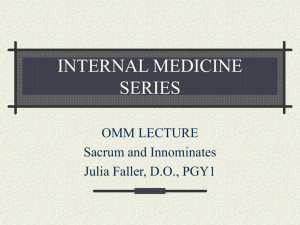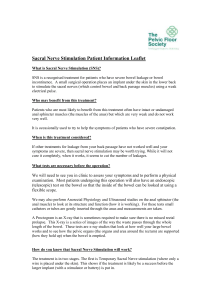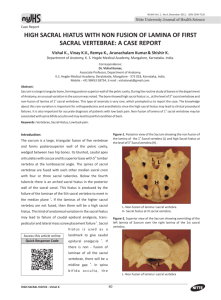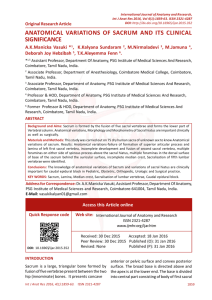Sacral Diagnosis - Oblique Axes, Neutral and Non
advertisement
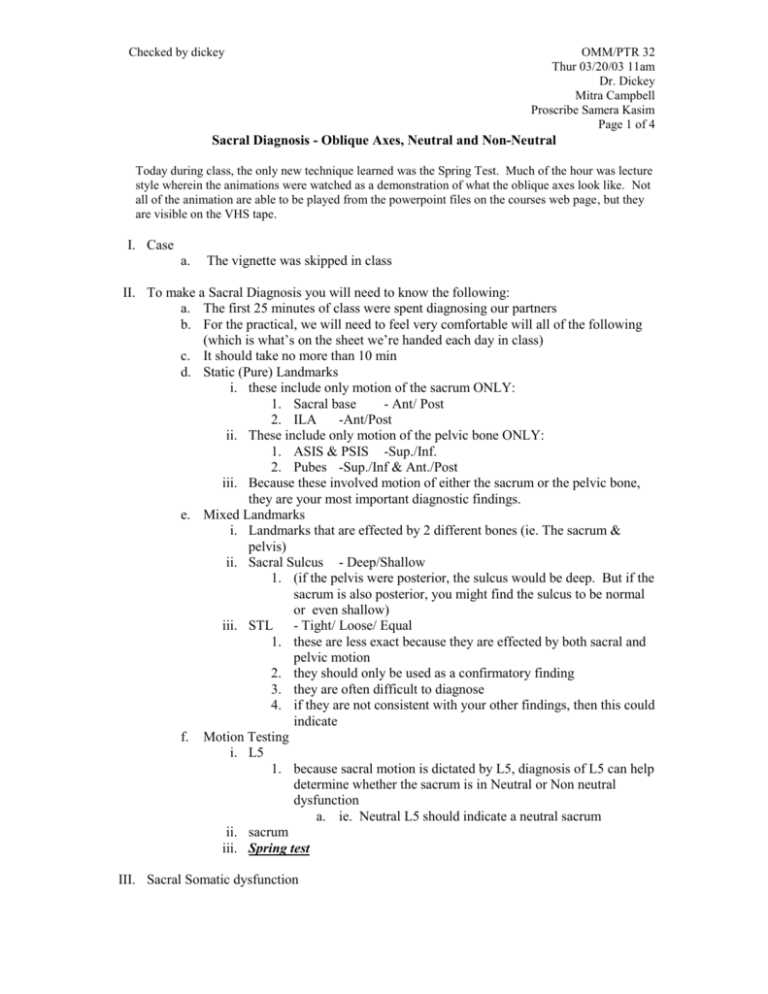
Checked by dickey OMM/PTR 32 Thur 03/20/03 11am Dr. Dickey Mitra Campbell Proscribe Samera Kasim Page 1 of 4 Sacral Diagnosis - Oblique Axes, Neutral and Non-Neutral Today during class, the only new technique learned was the Spring Test. Much of the hour was lecture style wherein the animations were watched as a demonstration of what the oblique axes look like. Not all of the animation are able to be played from the powerpoint files on the courses web page, but they are visible on the VHS tape. I. Case a. The vignette was skipped in class II. To make a Sacral Diagnosis you will need to know the following: a. The first 25 minutes of class were spent diagnosing our partners b. For the practical, we will need to feel very comfortable will all of the following (which is what’s on the sheet we’re handed each day in class) c. It should take no more than 10 min d. Static (Pure) Landmarks i. these include only motion of the sacrum ONLY: 1. Sacral base - Ant/ Post 2. ILA -Ant/Post ii. These include only motion of the pelvic bone ONLY: 1. ASIS & PSIS -Sup./Inf. 2. Pubes -Sup./Inf & Ant./Post iii. Because these involved motion of either the sacrum or the pelvic bone, they are your most important diagnostic findings. e. Mixed Landmarks i. Landmarks that are effected by 2 different bones (ie. The sacrum & pelvis) ii. Sacral Sulcus - Deep/Shallow 1. (if the pelvis were posterior, the sulcus would be deep. But if the sacrum is also posterior, you might find the sulcus to be normal or even shallow) iii. STL - Tight/ Loose/ Equal 1. these are less exact because they are effected by both sacral and pelvic motion 2. they should only be used as a confirmatory finding 3. they are often difficult to diagnose 4. if they are not consistent with your other findings, then this could indicate f. Motion Testing i. L5 1. because sacral motion is dictated by L5, diagnosis of L5 can help determine whether the sacrum is in Neutral or Non neutral dysfunction a. ie. Neutral L5 should indicate a neutral sacrum ii. sacrum iii. Spring test III. Sacral Somatic dysfunction Checked by dickey OMM/PTR 32 Thur 03/20/03 11am Dr. Dickey Mitra Campbell Proscribe Samera Kasim Page 2 of 4 a. Axis – a plane that cannot move, but about which motion occurs. b. Takes on 2 forms: c. Physiologic: i. Dysfunction that occurs around a Physiologic Axis 1. Vertical 2. Transverse 3. Oblique: Neutral and Non-Neutral d. Non - physiologic: i. Dysfunction that does not occur around an axis. Usually caused by trauma ii. This was what Tuesday’s lecture was about 1. Upslipped Innominate 2. Unilateral Sacral Shear (Unilateral Sacral Flexion) IV. Spring Test a. It’s purpose: To be an indicator of whether you are dealing with a NN (backward torsion) sacral Oblique Axis V. Why are the Oblique Axes so significant? a. The walking cycle as it applies to our discussion: b. From a standing (neutral) position, when you take a step forward, your weight is shifted onto one lower extremity. c. This induces spinal column SB to the weight bearing side, and pins the upper pole of the sacrum on the side of the SB. d. As the free lower extremity swings forward, it carries the free pole of the sacrum anterior, creating rotation of the sacrum about the Oblique Axis, towards the weight bearing extremity e. From a standing (neutral) position, as you step forward, note how your body compensates. What does your torso do? f. Answer: Rotates towards the moving lower extremity (ie.: away from the weight bearing lower extremity). g. Bottom Line: Your spine (most notably Lumbar spine) rotates in the opposite direction of the sacrum in a neutral moving situation. h. EXTRA NOTES: the sacrum is a suspended, floating structure. Shifting weight to the Left will impinge the upper L pole nd the lower R pole. i. If the walking cycle is interrupted, then dysfunction can occur. VI. Neutral - Left Oblique Axis Findings (LOA) a. Animation showed what this looks like b. Sacrum moves forward c. If you were to place a dot on the front of the sacrum at the upper R pole, it would turn slightly toward the L as it moves forward. The L inf border moves backward and slightly inferiorly. d. Most sacral motion is FB in neutral mechanics e. Once a L oblique axis is formed, only the R sacral base moves forward. f. With sacral shear, there is marked inferiorness of the ILA g. With sacral Torsion, there is marked posteriorness h. Named various ways: Checked by dickey i. j. OMM/PTR 32 Thur 03/20/03 11am Dr. Dickey Mitra Campbell Proscribe Samera Kasim Page 3 of 4 i. L on LOA, ii. RL (rotated Left) on LOA, iii. L Forward Torsion Or simply Left on Left What you’ll find: i. Lateralization: Left ii. Landmarks: iii. Sacral Sulcus: L shallow iv. Sacral Base: L posterior v. ILA: L Post/ Inf. 1. the finding that is most prominent is written first; if this were a sacral shear, it would be “Inf/Post” vi. STL: L Tight vii. Motion Testing: viii. Spring: negative 1. (a negative spring test is indicative of motion. If there is no motion and they have forward bent somatic dysfunction, then the test is positive and points toward backward torsion) ix. L5: SLRR 1. notice this is also neutral x. Sacral Base: LR+ 1. you would not expect motion at the L upper (R sacral base) and R lower poles (R ILA) because these lie along the axis, which doesn’t move!! xi. ILA: L +/- R +/- VII. Neutral - Right Oblique Axis Findings a. Animation showed what this looks like b. Findings are reversed from above c. Name: i. R on ROA, ii. RR on ROA, iii. R forward torsion d. or simply “Right on Right” e. what you’ll find: i. Lateralization: Right ii. Landmarks: Sacral sulcus: R shallow Sacral base: R posterior ILA: R Post/Inf. STL: R tight iii. Motion Testing: Spring: negative L5: SRRL Sacral Base: L+ RILA: L +/- R +/VIII. Non-Neutral Sacral Dysfunctions - Left Oblique Axis Findings Checked by dickey OMM/PTR 32 Thur 03/20/03 11am Dr. Dickey Mitra Campbell Proscribe Samera Kasim Page 4 of 4 a. b. c. d. NN occur with either extreme BB or FB greater than 90 degrees. The sacrum begins to move backward in NN mechancs Not as common; seen in mailmen, manual labor… Name: i. R on LOA, ii. RR on LOA, iii. L Backward Torsion e. Lateralization: Left f. Landmarks: i. Sacral Sulcus: L Deep ii. Sacral Base: L Anterior iii. ILA: L Ant/ Sup iv. STL: L Loose g. Motion Testing: i. Spring: + ii. L5: RLSL 1. also NN iii. Sacral Base: LR +/iv. ILA: L+ R +/1. again, no/little motion detected at the pole that make the axis (upper L and lower R) IX. NN: Right Oblique Axis findings a. Name: i. L on ROA, ii. RL on ROA, iii. R backward Torsion b. Lateralization: Right c. Landmarks: i. Sacral Sulcus: R Deep ii. Sacral Base: R Anterior iii. ILA: R Ant./Sup. iv. STL: R loose 1. when the ILA moves forward, it approaches the ischial tuberosity and the ligament becomes loose. d. Motion Testing: i. Spring: + ii. L5: RRSR iii. Sacral Base: L +/- R iv. ILA: L +/- R +
